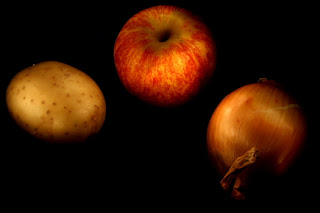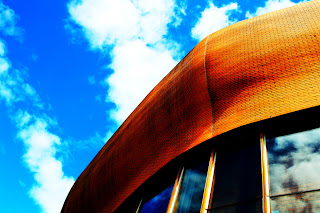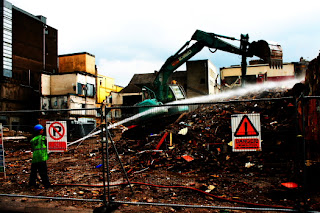Telephoto lens is a very useful piece of kit in any photographers bag. The lens is useful in many ways, one - the most obvious is the ability to fill the frame with a subject that is far away, it's helpful in situations when you can't get close to your subjects, like a football game or wild animals.
Any focal length above 50mm can be considered as telephoto, say 70mm or 135mm etc. There are two types of telephoto lenses: prime lenses and zoom lenses. Prime lenses are lenses with fixed focal length. This means that the lens can't be zoomed in or out. This type of construction uses less elements and therefore less glass. Usually prime lenses are high quality, professional grade products and the maximum aperture is wider than in consumer lenses.
Zoom telephoto lenses allow you to change the focal length in the range the lens is constructed. For instance 70 - 300mm. These lenses are constructed using more elements than in prime lenses, therefore more glass is needed, and maximum apertures are not so wide as in prime lenses to keep the cost low. There are professional grade zoom lenses with wide maximum apertures, but they are very expensive bulky and heavy.
Other good way to utilize this type of lens is to use it in portrait photography: use the long end of the lens (150 - 300mm) and a wide aperture (f5.6 or wider), place your sitter some distance away (the farther, the more blurred the background will be) from the background and focus on the eyes (the closest eye to the lens if the subject is turned). This technique will give you portraits with nicely blurred backgrounds and shallow depth of field.
Another use is in close-up photography, like flowers and other small objects. Long lenses compress perspective in the images compared to wide angle ones, if you will take a picture of telegraph poles from a side angle with a wide angle lens they will appear much apart, but if you will use a telephoto lens instead and frame the scene the same way as previous (you'll have to stand farther because long lenses bring everything closer) the poles will appear kinda compressed and closer to each other. Lenses are tools you can use creatively to achieve the incredible shots you're after.
4.12.07
Telephoto lenses
Author
Sheriff
at:
15:40
1 Comments:
![]()
Lables: Lenses
11.11.07
How to make money with photography blog
Few days ago I stumbled across this blog (blogs.photopreneur.com), and I find it quite useful for those photography enthusiasts who are into making money out of photography. Articles like "52 ways to monetize your photos", "47 things people will pay you to shoot" etc.
Check it out if you have interest. Very well put together articles and interesting too.
Photopreneur
Author
Sheriff
at:
17:24
0
Comments:
![]()
Lables: Photo busines
24.10.07
What is ISO in photography?
ISO stands for International Standards Organization. How does that relate to cameras? ISO standardizes a lot of different industries, and photography as well.
It is used to standardize film sensitivity to light, in digital cameras a ISO equivalent is used. The lower the ISO value the less sensitive the film or image sensor is to light. The higher the value the more sensitive the film or image sensor is to light.
In cameras it affects the saperture and shutter speed setting combination to achieve a correct exposure.When light levels are low, the shutter speed will be slow, and that affects the images dramatically. So in order to increase the shutter speed you need to increase the ISO. With film you would need to change the roll to one with a higher ISO sensitivity. With digital cameras you just need to change the setting.
How does it affect the image quality? Well, with film it adds more grain to images, with higher sensitivities, it can add a mood to an image. With digital sensors it adds more noise, with higher sensitivities.
The bottom line is to use the lowest ISO setting possible in order to increase the image quality. Larger sensors produce less noise at higher sensitivities then smaller ones. So, a DSLR with a full frame sensor, such as Canon EOS 5D will produce a considerably higher quality image then a camera with a smaller image sensor.
Noise can be battled effectively with a help of software, such as Neat Image, so if you need to use high sensitivity, use it, its better to have the image to work on, then have no image.
One more way to avoid using high ISO sensitivities is to use a fast (wide aperture) lens, with a maximum aperture at least of f2,8 or faster on your DSLR. This will allow more light to reach the sensor, thus increase the shutter speed and you will be able to use a lower ISO setting.
In general, all new DSLR cameras have a very good noise performance up to ISO 400, above that results differ, with full frame models doing better. Point and shoot cameras perform poorly because of their tiny sensors and to much pixels crammed on them.
So, always try to keep the ISO setting as low as conditions allow and you will increase the quality of your images.
Author
Sheriff
at:
22:39
0
Comments:
![]()
Lables: Introduction
Exposure bracketing in photography
Exposure bracketing, that's another thing to learn in order to better understand how photography works.
Well it ain't that complicated as it sounds. It's exactly what it says on the tin. You bracket the exposure that camera thinks is correct with two more exposures, one underexposed (darker image) and one overexposed (lighter image).
So, how that works and what it's for? Let's say you are about to take a picture of a complicated scene, such as a sunset on a seaside. In this case it's complicated because the sun is so bright, that it can easily confuse the camera meter. The meter will think: wow, that's bright, I'll have to expose it "correctly". And more often the image will come out underexposed, not exactly what you would expect. Now, what you do is you bracket your exposures. This setting, when turned on, will set the camera to shoot three differently exposed frames, one underexposed, one normally exposed and one overexposed. You will have to push the shutter release button three times to get your three frames. Question: how different the exposures will be? This is up to you. When you set the exposure bracketing you set the values your self. This is measured in stops, you can set 1/3 of a stop in most modern cameras too. So, in the case of the sunset we will bracket by at least one stop, even two would turn out better. Then you can choose the best exposure.
In the old, film days, this was a popular technique to ensure a good exposure, especially when using filters. In the case of the sunset there could be done more then one bracketing with different settings to get just one picture. That's because you couldn't see what you're getting until the film is processed. But now we have digital cameras and we can check the exposure on the spot and then adjust it as necessary. But that doesn't mean that bracketing is unnecessary, the small (compared to a computer monitor) camera display isn't the best way to judge the exposure, so you can bracket as many as you need and check on your computer, and choose. And it won't cost you a dime.
Author
Sheriff
at:
20:38
1 Comments:
![]()
Lables: Introduction
21.10.07
Exposure triangle in photography
Exposure is determined by three factors: number one is aperture, number two is shutter speed and number three is ISO setting (sensitivity value of the film or sensor).
Any change in one of these factors will result in a change in the exposure. So, if one factor is changed, but exposure has to remain the same, then second of these factors have to be adjusted accordingly.
Now, lets see how it works. Lets say our ISO setting is 200 and aperture is f2.8 and the shutter speed is 1/250 of a second. And let's assume that these settings will result in a correctly exposed image in the lighting conditions we're in. So, lets change the ISO setting from 200 to 100 because the lower ISO will give us better quality image with less noise. By doing this the exposure will become underexposed (darker image) by one stop. Stop is a term to describe the amount of exposure change. Now we need to adjust either aperture or shutter speed, in order to correct the exposure, we need to compensate for reduction in sensitivity. We need to allow more light to reach the film or sensor. So, we decrease the shutter speed by one stop, that results in 1/125 of a second, half of the original value. By doing this we retain the aperture value the same - f2.8. If we need the shutter speed to remain at 1/250 of a second than we can increase the aperture from f2.8 to f1.4 by one stop, this way we compensate for reduction in sensitivity by letting in more light during the same time frame.
When exposure values are being set we need to prioritize what is important, depth of field (aperture value) or freezing/blurring a moving subject (shutter speed), image quality (ISO setting). When we got our priorities right we can set the values accordingly.
All modern cameras have built in light meters, which measures the light and can determine what is the correct exposure, this helps us. We only choose two values and the camera can set the third accordingly. Use aperture priority mode on your camera if you need a certain aperture, or use shutter priority mode if you need a certain shutter speed, assuming that you have chosen your ISO sensitivity beforehand. If you want full control of the exposure, you can use manual mode in which you have to set both, aperture and shutter speed.
One more way to change the exposure is by using exposure compensation setting, which allows you to tell the camera by how much it should underexpose or overexpose the image. Thing is, that cameras aren't as smart as we are, so exposure errors occur in difficult situations which fool the meter. And in these situations you, the photographer step in and correct things as they should be.
Author
Sheriff
at:
19:08
1 Comments:
![]()
Lables: Introduction
20.10.07
Shutter setting in photography
Shutter is an important setting. From the previous post we found out that aperture determines the amount of light reaching the sensor or film, the shutter determines the time for how long the light reaches the sensor or film.
It also determines if a moving subject is frozen still or blurred. In itself shutter is a curtain or set of leaves (just like aperture) which moves (opens and closes) in front of the sensor or film in order to control the light reaching it. Together with aperture shutter determines the exposure of an image, we'll take a closer look at that in the next post.
The latest DSLR's will offer you a shutter speed range from 30 sec. to 1/4000 sec. This is pretty useful. So how we use this choice? Let's say you are taking a picture of a waterfall, if you will choose high shutter speed then the falling water will "freeze" in action, the image will look static, but if you set your shutter speed to say 1/60 th of a sec. then the falling water will actually look like in motion, because it will be blurred by using slow shutter speed.
Now another useful way to use the shutter speed setting is when you are taking a portrait picture in bright light you want to use a large aperture in order to blur the background and thus separate your subject from it, but you risk overexposing the image. So in this case you should use a high shutter speed to limit the bright light.
You can use semi automatic settings like Aperture priority, where you set the aperture you need and the camera will choose the right shutter speed to get a correctly exposed image, or you can use Shutter priority setting for setting the needed shutter speed and the camera will set the appropriate aperture to get a correct exposure. So you should choose the appropriate mode for your priorities, either its depth of field or freezing or blurring the action.
Author
Sheriff
at:
13:18
0
Comments:
![]()
Lables: Introduction
Aperture setting in photography

Aperture is a setting that determines the amount of light reaching the surface of the sensor or film. It is located inside the lens. Aperture is made up of a number of very thin blades which form a circular opening and are able to change the diameter of this circle by fanning in or out.
When the aperture is set to f1.4, for example, the amount of the light reaching the sensor or film will be much greater then if it would be set to f22. So, the smaller the number, the larger the aperture and vice versa. Each lens has a set number of apertures it can do, generally it will be something between f4 and f32, this is determined by the design of the lens. There are lenses capable of apertures as wide as f1.2 and as narrow as f64. The aperture values in between the maximum and minimum aperture are adjustable. These are called stops, each stop changes the exposure by half. This way it is possible to control the exposure.
Other thing aperture controls is depth of field, if the lens is focused on a close distance and the aperture is set to widest setting then the image will come out with blurred background and foreground, if the aperture will be set to narrowest setting then of the image will be in sharp focus, this distance in front of subject and behind is the depth of field. There are other factors that contribute to the depth of field, such as the distance from lens to subject, from subject to background distance and the focal length of the lens, all of these factors, plus the aperture determine the depth of field of the resulting image.
Author
Sheriff
at:
12:32
0
Comments:
![]()
Lables: Introduction
13.10.07
What a camera is and how it works?
The most simple answer would be this: a camera is a light tight box with a lens attached or no lens at all (pinhole camera) and a light recording media in it (film, digital sensor).
OK, that's to simple isn't it? Let's go a bit deeper. The most important parts of any camera are: the light tight box - the film/sensor chamber, lens, shutter and aperture. SLR cameras have a mirror and a pentaprism.
Now, let's talk about each of them. Film/sensor chamber is a black, light tight box to ensure that no stray light gets inside it so the photographer can control the amount of light getting inside. The shutter is a device to control the light entering the film/sensor chamber. Aperture is another way to control the amount of light entering the camera. And the lens is a device to do all kinds of tricks with light by bending the light waves.
So, now we'll put it all together. Let's say we're taking a picture of a flower. The light coming from the sun reflects off the flower and travels into our lens, there, with the help of optical elements it is adjusted, then it travels through aperture, which is an adjustable hole (we'll take a closer look at it in the next post), then it is up against the shutter - the main door, the shutter is opened by a photographer for a certain time (now exposure is in progress), the film/sensor now records the image of the flower. The shutter closes, the job is done, you have the picture.
OK, these are the basics of any camera, in next posts we'll go through more complicated processes in picture taking technology.
Author
Sheriff
at:
20:15
0
Comments:
![]()
Lables: Introduction
What is photography?
What is photography? Good question, simple answer. Photography is painting with light when translated to English. So, how it happens?
We see the world around us because of the light, if there is no light we see nothing. The light reflects from objects and our eyes capture the light, then our brain processes the information and gives us an image of what we see.
What that has to do with photography? Well, our eyes and brain effectively makes a very advanced camera which gives us 3D images, millions of colors and super high resolution. If we understand how our sight works, we can understand how a camera works.
The eye of the camera is the lens, it gathers the light reflected from objects, then the light ends up on the sensor or film where it is recorded, and finally the processor (in case of a digital camera) or developer (in case of a film) processes the information and gives out an image.
Pretty simple isn't it? But there is something more to it, cameras don't take images themselves, we have to use our mind to get the pictures, and here starts photography - camera plus photographer.
Photographer creates the image, the lens sees it and the camera records it. Now, that is photography in few words.
Author
Sheriff
at:
17:19
0
Comments:
![]()
Lables: Introduction





